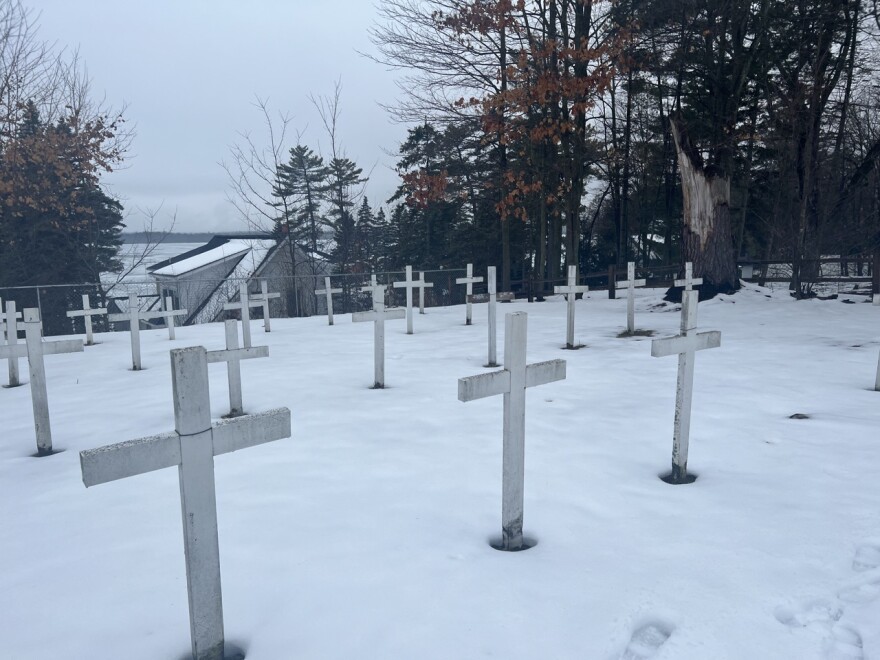On the top of a hill, overlooking an icy Burt Lake, Ken Parkie walks through a small cemetery filled with a few dozen white crosses.
He scans the land, looking for signs of an old settlement. He points across Chickagami Trail to a group of trees.
“I was always told it was down in that area,” Parkie says. “About where that valley is, back that way. That’s where I was always told it was at.”
The people buried in the cemetery died around the time of the ‘Burt Lake Burnout’ — the violent colonization of the Burt Lake Band’s village.
Their names are written on a rock near the entrance. Parkie suspects several of his ancestors are buried there.
The sign at the entrance bearing the flag of the Burt Lake Band is one of few indications that a thriving native settlement stood here more than a century ago.

The burnout
Down the hill are lakeside cottages and across Chicagami Trail are the old trees of the Cheboiganing Nature Preserve. Back when the village was here, the peninsula was called “Indian Point.”
But in 1900, a group of men including a sheriff and a land speculator torched the settlement, leaving about 25 families homeless.
A new book, “A Cloud Over the Land,” by historian Richard Wiles, documents the first people and culture on the lake and legal battles that took place around the burn-out.
Burt Lake Band member and historian Deborah Richmond played a major role in compiling the book with Wiles, an honorary member of the tribe.
She said the settlement would have begun as traditional wigwams, a dome-shaped shelter covered in bark or hides, but that it eventually became log cabins for the Band to establish a more permanent residence on the Indian Point.
“These would have been log cabins with lumber from the sawmill,” Richmond said. “They knew we were going to need to just start living in a more permanent place here.”
But then came Oct. 15, 1900.
According to “A Cloud Over the Land,” it was a cloudy day as the men of the village left to go get their paychecks from working at the local sawmill from Cheboygan — an approximately 40-mile trip on foot.
“Along came a wagon with several men in it,” Richmond said. “One of them was the local sheriff. One of them was a developer who had been trying to get a hold of their reservation land. And the sheriff had brought several men with him for backup. What these men did was they came through house by house and threw all of the women and children and elderly who were there for the day out of their houses. And then they started pouring kerosene on every single cabin, one by one.”
The men lit the kerosene, burning down nearly every building in the settlement and sending the women and children to walk in the rain to a few other indigenous homes miles away from the village.
Saint Mary’s Catholic Church, its cemetery and a log cabin rectory were the only things that survived the blaze.
The church eventually came down after being used as the land developer’s pig barn, but Parkie said you can still see its foundation behind the trees.
“The church (property) was probably 260 feet across the back and about 800 feet from the shoreline,” Parkie said. “That’s what the church used to own. Now all they got is the cemetery.”
The developer, a man named John McGinn, claimed that the Native Americans owed taxes on the property and that he had purchased the tax lien.
But the Burt Lake Band had purchased the land from the governor of Michigan years before. It was already federally recognized by the federal government in the 1836 Treaty of Washington which also provided that the Band would receive a reservation of 1,000 acres on Burt Lake.
What ensued were decades of legal battles to reclaim parts of the peninsula which was later called Colonial Point in some maps.

Preserving the story
Richmond said “A Cloud Over the Land,” documents all of the legal battles that also involved the stripping of the Band’s treaty rights.
“[Richard Wiles] has spent the last probably 10 years focusing on the burnout,” she said. “He dug into many libraries, museums, archives, newspapers, everything he could get his hands on, in order to put together this level of detail — especially with the treaties and with the lawsuit and transcripts.”
Instead of violence, “A Cloud Over the Land” notes that the Burt Lake Band responded with “grief, and with practicality, and with memory.”
Richmond says the grief is still felt today but that the book will remind the region and the country the Burt Lake Band remains.
“Only now when we can tell our own story, and when people can hear our story, are we allowed to start healing,” Richmond said. “We would like to focus on the good parts of our culture. But it very much is a cloud over our families and over our history because we want to right the wrongs that happened to our ancestors.”
“A Cloud Over the Land” is available to purchase on the Burt Lake Band website. In its first few weeks, the book has already sold approximately 150 copies.



